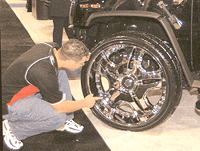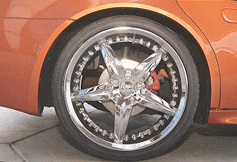According to many tiremakers, the Ultra-High Performance (UHP) tire market is full speed ahead. Many have seen the explosion of this market over the past couple of years, and there’s nothing on the horizon that indicates the explosive growth won’t continue.
In 2003, the performance tire market increased at a rate greater than it’s ever increased before, and the market is expected to continue to grow.
In fact, many industry insiders say the trend of changing the look of the car by changing the tires and wheels is going to continue. But growth will also come because the performance tire market is moving into segments that it wasn’t in before.
The tire industry is beginning to see 20-inch tires for light trucks in all- terrain patterns. That’s because consumers are taking their vehicles – even trucks with lift kits – and giving them more of a sports car look with bigger wheels and tires. For dealers, this will present an even greater proliferation of tires and sizes.
 All the Rage
All the Rage
Look around. It seems everything nowadays comes with huge wheels and low-profile tires. And it’s only going to continue. Just look at the newest generation of balancers and changers – they’re no longer designed to handle the smaller tires.
As a student preparing to enter the tire industry, you can expect that for at least the next three to five years, the performance tire market will continue to steadily grow. And it’s no longer just extreme tuners who are buying large diameter tire and wheel packages for their vehicles. You can see 18- and 20-inch tire/wheel fitments on the “soccer mom” SUVs as a normal wheel option these days.
Which is why some tire makers believe the definition of “performance tires” is going to change. If soccer moms are driving minivans with 18-inchers on them, or some 50-year-old has a big set of 20-inch chrome wheels that came original equipment (OE) on an SUV, the idea of a performance tire has been skewed.
Some say the term “performance” doesn’t necessarily fit anymore, and that’s because “performance” no longer just literally means how a tire performs. It also means how it looks. With the popularity of plus-sizing, performance is now often appearance related.
Some suggest that maybe it’s time that the tire industry comes up with a new term for performance tires because they encompasses so much more.
But where should the new term for performance tires be applied? A quick pass through the 2003 ITE/SEMA Show floor revealed that the tire/wheel assemblies are bigger this year than they were last year. And it’s doubtful they’ll be smaller for this year’s show. That’s because OE wheels are larger – hence the 50-something with 20-inch wheels – which means replacement has to keep up. Throw in the still-hot customization side and there’s no slowdown in sight.
From an OE position, tire makers continue to see the evolution to larger wheel/tire diameters and higher performance ratings. And that trend certainly translates to the replacement market as those consumers have to replace their tires.
Maybe you have experienced this trend yourself, where you, as a consumer, upgraded the performance of your vehicles through customization. Wheels and tires are typically the first enhancement, and with a growing population of younger car owners like yourself, that trend will continue to be a major contributor to the performance market.
Influences from the OEMs
There’s an old joke about what OE manufacturers demand out of a tire. “There are three criteria. They have to be round, black and cheap. And OEMs don’t really care much about the first two.”
Seriously though, the OE market has a major impact on the performance market. Whatever tire is put on as OE will have to be replaced in two or three years. And, OE is trending toward more high performance-orientated tires.
 Why? Well, OE is having more of an effect on the performance tire market because they are using more ultra-high performance fitments, and often on vehicles that previously weren’t considered performance vehicles.
Why? Well, OE is having more of an effect on the performance tire market because they are using more ultra-high performance fitments, and often on vehicles that previously weren’t considered performance vehicles.
For example, the Ford F-150 Harley Davidson Edition comes with 20-inch wheels and UHP tires. Owners of these and other such vehicles are what we call “accidental” performance tire buyers because they often don’t realize that their vehicle has performance tires until it’s time to replace them.
Many of today’s compact cars are available with optional wheels that come with performance tires. People who buy these cars may buy them because they like the look, but when it comes time to replace the tires, they have to buy performance tires.
So, what was previously considered an aftermarket tire fitment is now an OE replacement fitment since tire manufacturers are now making standard- or touring-type tire products in what were traditionally ultra-high performance tire sizes.
Also, the OEMs are offering more niche vehicle choices than ever before in hopes of addressing specific consumer segments. As new categories of vehicles, like the so-called “cross-over” vehicles, are produced, tire manufacturers will have to respond with products that specifically address the needs of those customers.
It’s interesting to note that while OE drives replacement, in regards to the performance market, OE is following the replacement market’s lead. For now, it seems that performance OE fitments are contributing significantly to the replacement market because of customization.
For instance, often times, sport compact enthusiasts will take a vehicle that was purchased with S-, T- or H-rated tires and upgrade the performance of the vehicle simply by adding new wheels and Z-rated performance tires. This trend shows up in RMA reporting of Z-rated performance sales, where several of the most popular sizes have no parallel OE fitment.
Car manufacturers are now taking a lot of their tire sizing and performance cues from trends in the replacement market. Some say by 2005, more than one-third of OE fitments will be 17 inches or above.
Tuning In
Another market that’s starting to guide OE direction is the tuner segment. OEMs have increased tire size, changed wheel offerings and are even selling what could be considered complete tuner vehicles – all in direct response to what they see going on around them.
The tuner market is starting to see more and more vehicles that are coming OE with larger wheel diameters and lower profile tires. Many sizes that were previously considered “tuner sizes” can now be found on new vehicles as either standard or an option.
But, as OEMs start producing a larger variety of vehicles to attack niche markets, the tuner market will, in turn, have to respond by making products for these new vehicles.
It should be noted that some OEMs have seen the huge growth in the tuner/customization market as an opportunity for them to sell more vehicles. The influence they are exerting is achieved by making their vehicles attractive to those consumers who are doing the customizing. Not just attractive from a styling standpoint – although that’s important – but also designing the vehicles in a way that makes it easier for the consumer to customize the car.
Carmakers, too, are taking in more of what is happening in the aftermarket and incorporating those elements into new vehicles so their designs will be more attractive to the tuner buyer. Cars like the Mini and the Ford Focus are a couple of examples. The tuner market isn’t just about the Honda Civics anymore – there are many models out there that appeal to a broader range of people. Some people buy cars like the Focus, Neon or Mini because they think these cars are “cool looking.” Or it could be a family guy who wants a small car, but doesn’t want the standard econobox, so he buys the upgraded model that happens to come with a tire size that’s traditionally been a tuner size.
“It’s Gunna Cost How #$*&$@$&*%# Much?”
Many times with today’s performance tires, the replacement customer experiences serious sticker shock. The customer made the vehicle purchase based on his or her needs and desires (mostly desires). Tire brand, line and size never came into the equation – until it’s time to buy replacements.
Now the customer’s at the local tire dealer wanting to know why replacement tires cost $179 each and why he/she can’t get four tires for that $179.
Naturally, when the time comes, you’ll explain all the features and benefits of the replacement tire and why it’s important to install that particular type of tire. But how can you sell a customer replacement tires when the customer can only see dollar signs?
If it is an OE tire, remind him that he bought the car because he likes the way it looks or drives. If it’s a specialty fitment that’s more expensive, you have to play up the features, benefits and the emotions that were there when the guy bought the car.
For example, if a consumer has a vehicle with a specialty tire on it, such as an 18-inch tire or a run-flat, the guy will have sticker shock when he discovers he can’t buy four tires for $99. You may have to remind him that the car he bought wasn’t the less expensive base model. He bought it for a reason, and the tires were part of that purchase decision.
The important point that you’ll need to understand is that selling tires to the performance market is not just about tires; you must also know about the car and why those tires are used on that particular car. In today’s performance market, tires are an integral component on the car – not a commodity. Cars are designed with very specific performance characteristics, which require tires that meet certain standards. If the tires can’t live up to those standards, the performance of the vehicle will suffer. But not every customer sees it that way. Especially at replacement time.
Granted, the consumer may not understand all the technical terms associated with performance tires, but they’ll probably figure out what you are really saying to them – that a lesser tire wouldn’t deliver the performance or safety they have become accustomed to experiencing while driving.
What’s In It for You
There are a couple of things that can help transition a customer who’s jittery about the price: better consumer education and sales personnel with hands-on experience. Though tires are highly engineered products that deliver a great deal of value to consumers, it is unfortunate that sticker shock is often a reality.
While pointing out tire features and benefits can help put a customer’s mind at ease, there is no substitute for real-world experience. Talking about it and showing it are two very different things. So, being able to convey this first-hand experience to consumers is much more credible and convincing than simply pointing out information in a brochure.
Performance enthusiasts want to buy from people who share their enthusiasm, passion and knowledge. And, the person that they buy from could be you.


